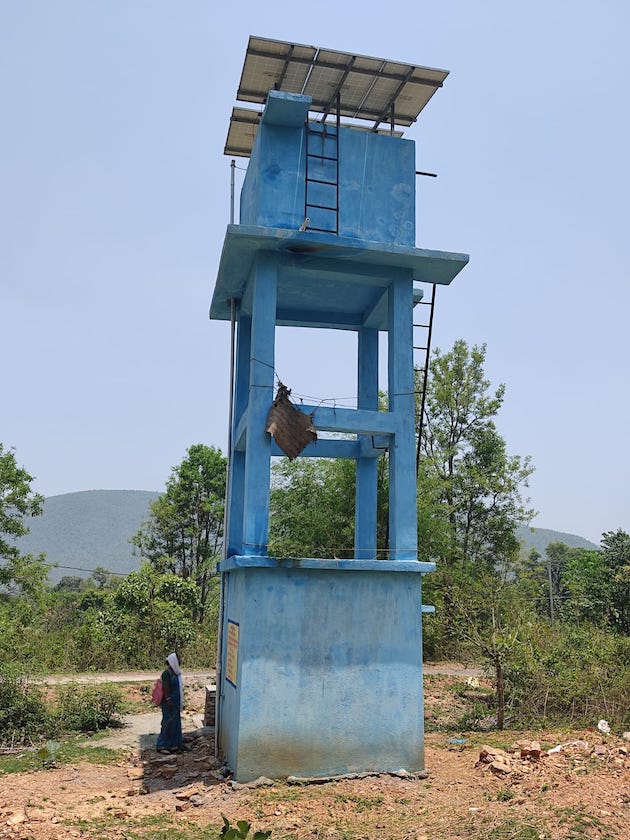Champad, India, Jul 04 (IPS) – Simita Devi spent over ten days in a government-run hospital a year ago anxiously watching her critically ill nine-year-old daughter, Gudiya, who was diagnosed with typhoid.
Gudiya was so sick she even went into a coma for a day. Medical staff attending to the child said she contracted the disease from drinking contaminated water.
After being discharged, Devi’s main worry was to get safe drinking water for her ailing daughter.
She was advised not to consume water from village wells or untested sources like river streams or springs.
Hailing from Champad, a tribal village in India’s Jharkhand state, Devi works as a daily wage labourer alongside her husband. With a limited income, Devi couldn’t afford packaged drinking water for her daughter.
She then decided to boil the water using firewood to make it safe to drink. But to get the firewood, she had to trek the treacherous terrains of the nearby forests – a long, difficult work and the fear of wild animals loomed.
It was not Devi alone impacted by contaminated water, it was making many people in her village ill, and there was nothing the inhabitants could do about it.
According to government records, 80% of India’s rural drinking water comes from underground sources. One-third of India’s 600 districts do not have safe drinking water because fluoride, iron, salinity, and arsenic concentrations exceed tolerance levels. India’s water quality is poor, ranking at 120 of 122 nations.

Experts believe that the source of these heavy metals is industrial waste being dumped untreated into water systems and nitrates which surface due to excessive and prolonged use of fertilizers. The government estimates that every year, over one lakh (100,000) people die of waterborne diseases in the country.
Champad, a village inhabited by a tribal community, has 105 households per the 2011 census. Until 2022, the community depended on only two tube wells as their source of drinking water. However, these tube wells often experienced malfunctions, leaving the villagers with no choice but to fetch water from a nearby river or pond. Consequently, there has been a rise in waterborne diseases, particularly affecting the health of women and children. The need to travel long distances for safe drinking water has increased women’s workload, increasing their workload.
Perturbed by the threat of waterborne diseases, the village locals congregated earlier this year to try to find a solution. They at first visited the local politicians for help. Then they headed towards government offices. “Nothing happened—absolutely nothing. We were virtually left high and dry. Except for God, no one is there to help us. At times, we were told to wait, and at times, we were told that government funding wasn’t available. But we were slowly dying. Our children are suffering in front of our own eyes,” Ram Singh, a local villager at Champad, told IPS.
Earlier this year, a team from a non-governmental agency working to uplift rural areas in India visited the village to assess the villagers’ hardships.
The agency then mooted the idea of a solar water tower in the village. The villagers were made aware of the process involved in the tower’s construction and that government approval for the facility was needed.
The village representatives were taken on board, and a proposal was submitted to the water department of the district.
“Government liked the idea, and it was readily approved. The entire village worked together to make the project a success story,” says a member of the humanitarian agency who wished to remain anonymous.
The towers were equipped with solar panels, enabling them to operate sustainably and with minimal environmental impact. The selection of sites for the towers was a collaborative effort involving the village communities. The first solar water tower was constructed in February 2023, while work on the other two towers is still ongoing. As a result, 45 families now directly benefit from the convenience of having clean drinking water channelled to their homes through pipelines. The water provided is of good quality and considered safe, in contrast to the open well water that was previously relied upon. This development has significantly alleviated the burden on women, who no longer have to travel long distances to fetch water from various sources.
The impact of this intervention was significant. The community’s health improved, and they were no longer at risk of waterborne illnesses. The women and children, who were often responsible for collecting water from distant sources, could now spend their time on other activities. The community’s overall quality of life improved, and they could focus on their livelihoods and education.
For Simita Devi, the facility is no less than a major solace in her life. She excitedly uses this water for drinking and thanks God for such an endeavour.
“Safe water means life for us. The solar tower has become a messiah for poor villagers like us. We will cherish the moments for life when we find its water coming to our homes,” Devi told IPS.
IPS UN Bureau Report
Follow @IPSNewsUNBureau
Follow IPS News UN Bureau on Instagram
© Inter Press Service (2023) — All Rights ReservedOriginal source: Inter Press Service
















